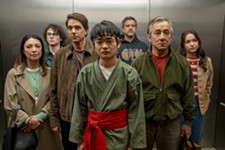
The Lost Leonardo
2021, PG-13, 96 min. Directed by Andreas Koefoed.
REVIEWED By Josh Kupecki, Fri., Sept. 3, 2021
“After drugs and prostitution, the art market is the most unregulated market in the world,” quips one of the assortment of engaging talking heads gathered by Danish filmmaker Andreas Koefoed for his latest documentary, The Lost Leonardo. That would be da Vinci, not DiCaprio (although the latter does make a cameo), and what resurfaced, after 500 years, was “Salvator Mundi,” a painting attributed to the most famous Renaissance master. Allegedly. Possibly maybe, as the song goes. It really depends on who you ask, and while complicated issues of authenticity make up a significant portion of Koefoed’s film, it’s his pursuit of the money through that opaque and unregulated market that reveals the more fascinating, if predictable, themes of greed, power, and deception.
So, a couple of art players buy this painting in New Orleans in 2005 for around $1,200. They’re convinced it’s a lost Leonardo and bring in Dianne Modestini, art restorer extraordinaire, to fix it up – which, after five years of work, she does. In that process, she has restored 85% of this painting depicting Jesus Christ clothed in the fashion of the (Renaissance) times. Now, in order to fetch a nice price at market, this thing has to be authenticated, so enter the experts. There’s a little known fact about art scholars and academics you may not be aware of: They tend to have a propensity for incredibly inflated egos. I know, who would have thought, right? Anyway, none of the scholars want to outright say that “Salvator Mundi” is legit, because what if they’re wrong? And none of the scholars want to say that “Salvator Mundi” is a fraud, because what if they’re wrong? (Art scholarship can be quite a nerve-racking vocation.) So they all agree that it might be an authentic Leonardo. Well, that’s not conclusive enough to fetch a nice price at market, so enter the museum curator. London’s National Gallery steps in and says, “Hey, not only will we confirm it’s authentic, we’ll put it on display and make loads of cash and increase its cultural capital!” Bingo! Sold in 2013 to a Russian oligarch for $127.5 million (well, actually $83 million, but that’s a whole other story). The Russian billionaire stores his trophy, er, painting in one of those cool, secret billionaire tax evasion warehouses called “freeports” (where they also store confusing time-reversal technology, but that is also a whole other story).
So when the Russian oligarch decides, as Russian oligarchs are apt to do, to liquidate his mobile assets, er, art collection in 2017, Christie’s auction house steps in and says, “Hey, not only will we sell this fabulous and completely legitimate Leonardo painting, we’re going to send it on a tour of world museums to make it even more famous (and also make us a lot of money)!” Which they do, launching a full-on blitzkrieg of publicity, which is where the other Leonardo pops up, seen in an ad campaign that equates seeing the painting with basically ascending to godhead. At this point, never mind any questions of authenticity, or that less than 20% of the painting is the work of Leonardo himself (probably), because, as we all are reminded of daily, all you have to do to prove an absolute truth is to keep repeating it. But who needs truth anyway when this commodity, er, painting breaks a world record and is sold for $450 million? To whom, you ask? Why, it’s everyone’s favorite authoritarian, the crown prince of Saudi Arabia himself, Mohammed bin Salman, and you know when MBS shows up in a doc (see: The Dissident), shit’s about to get real.
“Salvator Mundi” is now stored on a yacht somewhere, tucked away like the Ark of the Covenant, which is pretty perfect, metaphorically speaking. That whole art-versus-commerce bit was so 20th century anyway, and Koefoed’s film takes undeniable glee in pointing this out, over and over again. And while some of the re-creations of clandestine meetings and shots of faceless men transporting the painting can be a bit cloak-and-dagger cheesy, that’s the only stumble in a film that tells a strange tale populated by a cast of eccentric and dangerous characters. It’s another peek, along with 2018’s The Price of Everything and 2017’s Blurred Lines: Inside the Art World, into the high-finance world of paintings as investments. As the song goes, “Eyes down, round and round/ Let’s all sit and watch the moneygoround.”
A note to readers: Bold and uncensored, The Austin Chronicle has been Austin’s independent news source for over 40 years, expressing the community’s political and environmental concerns and supporting its active cultural scene. Now more than ever, we need your support to continue supplying Austin with independent, free press. If real news is important to you, please consider making a donation of $5, $10 or whatever you can afford, to help keep our journalism on stands.
Aug. 16, 2024
May 10, 2024
The Lost Leonardo, Andreas Koefoed









